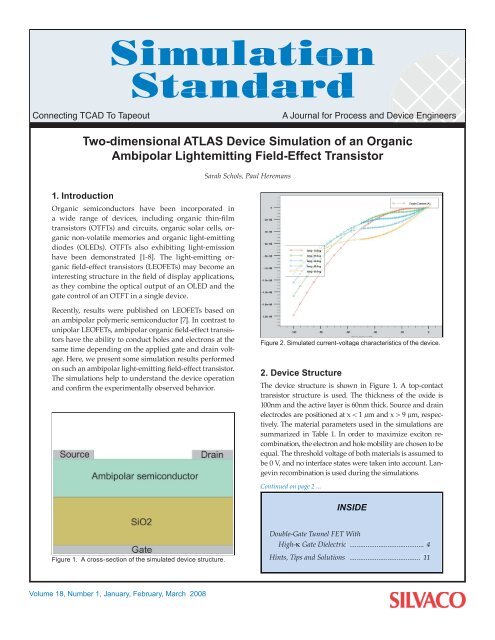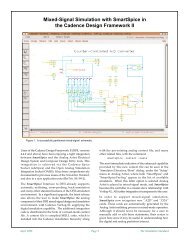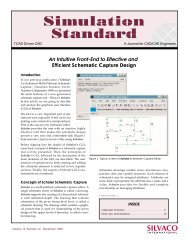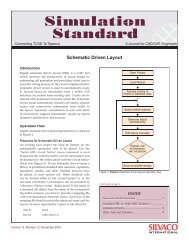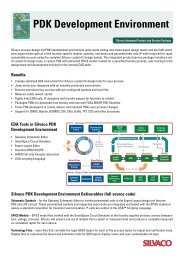Two-dimensional ATLAS Device Simulation of an Organic ... - Silvaco
Two-dimensional ATLAS Device Simulation of an Organic ... - Silvaco
Two-dimensional ATLAS Device Simulation of an Organic ... - Silvaco
You also want an ePaper? Increase the reach of your titles
YUMPU automatically turns print PDFs into web optimized ePapers that Google loves.
Connecting TCAD To Tapeout A Journal for Process <strong>an</strong>d <strong>Device</strong> Engineers<br />
<strong>Two</strong>-<strong>dimensional</strong> <strong>ATLAS</strong> <strong>Device</strong> <strong>Simulation</strong> <strong>of</strong> <strong>an</strong> Org<strong>an</strong>ic<br />
Ambipolar Lightemitting Field-Effect Tr<strong>an</strong>sistor<br />
1. Introduction<br />
Org<strong>an</strong>ic semiconductors have been incorporated in<br />
a wide r<strong>an</strong>ge <strong>of</strong> devices, including org<strong>an</strong>ic thin-fi lm<br />
tr<strong>an</strong>sistors (OTFTs) <strong>an</strong>d circuits, org<strong>an</strong>ic solar cells, org<strong>an</strong>ic<br />
non-volatile memories <strong>an</strong>d org<strong>an</strong>ic light-emitting<br />
diodes (OLEDs). OTFTs also exhibiting light-emission<br />
have been demonstrated [1-8]. The light-emitting org<strong>an</strong>ic<br />
fi eld-effect tr<strong>an</strong>sistors (LEOFETs) may become <strong>an</strong><br />
interesting structure in the fi eld <strong>of</strong> display applications,<br />
as they combine the optical output <strong>of</strong> <strong>an</strong> OLED <strong>an</strong>d the<br />
gate control <strong>of</strong> <strong>an</strong> OTFT in a single device.<br />
Recently, results were published on LEOFETs based on<br />
<strong>an</strong> ambipolar polymeric semiconductor [7]. In contrast to<br />
unipolar LEOFETs, ambipolar org<strong>an</strong>ic fi eld-effect tr<strong>an</strong>sistors<br />
have the ability to conduct holes <strong>an</strong>d electrons at the<br />
same time depending on the applied gate <strong>an</strong>d drain voltage.<br />
Here, we present some simulation results performed<br />
on such <strong>an</strong> ambipolar light-emitting fi eld-effect tr<strong>an</strong>sistor.<br />
The simulations help to underst<strong>an</strong>d the device operation<br />
<strong>an</strong>d confi rm the experimentally observed behavior.<br />
Figure 1. A cross-section <strong>of</strong> the simulated device structure.<br />
Sarah Schols, Paul Herem<strong>an</strong>s<br />
Figure 2. Simulated current-voltage characteristics <strong>of</strong> the device.<br />
2. <strong>Device</strong> Structure<br />
The device structure is shown in Figure 1. A top-contact<br />
tr<strong>an</strong>sistor structure is used. The thickness <strong>of</strong> the oxide is<br />
100nm <strong>an</strong>d the active layer is 60nm thick. Source <strong>an</strong>d drain<br />
electrodes are positioned at x < 1 µm <strong>an</strong>d x > 9 µm, respectively.<br />
The material parameters used in the simulations are<br />
summarized in Table 1. In order to maximize exciton recombination,<br />
the electron <strong>an</strong>d hole mobility are chosen to be<br />
equal. The threshold voltage <strong>of</strong> both materials is assumed to<br />
be 0 V, <strong>an</strong>d no interface states were taken into account. L<strong>an</strong>gevin<br />
recombination is used during the simulations.<br />
Continued on page 2 ...<br />
INSIDE<br />
Double-Gate Tunnel FET With<br />
High-κ Gate Dielectric ......................................... 4<br />
Hints, Tips <strong>an</strong>d Solutions ....................................... 11<br />
Volume 18, Number 1, J<strong>an</strong>uary, February, March 2008<br />
J<strong>an</strong>uary, February, March 2008 Page 1 The <strong>Simulation</strong> St<strong>an</strong>dard
P-type N-type<br />
LUMO (eV) 2.9 3.4<br />
HOMO (eV) 5.4 5.4<br />
µ (cm 2 /Vs) 1 10 -3 1 10 -3<br />
Table 1. Summary <strong>of</strong> the material parameters used in the<br />
simulations.<br />
(a) Vg=-50V <strong>an</strong>d Vd=-40V<br />
Hole Accumulation<br />
(b) Vg=-50V <strong>an</strong>d Vd=-75V<br />
Hole Accumulation<br />
(c) Vg=-50V <strong>an</strong>d Vd=-100V<br />
Hole Accumulation<br />
3. Results <strong>an</strong>d discussion<br />
Figure 2 shows the simulated output characteristics <strong>of</strong><br />
the device for negative drain (x-axis) <strong>an</strong>d negative gate<br />
voltage. These characteristics c<strong>an</strong> be explained by the<br />
fact that holes <strong>an</strong>d electrons are injected at the same time<br />
when the applied gate voltage Vg obeys Vs=0V > Vg > Vd,<br />
in other words |Vd|>|Vg|. When |Vd| < |Vg|, only holes<br />
Electron Current Recombination<br />
Electron Accumulation Recombination<br />
Electron Accumulation Recombination<br />
Figure 3. Simulated hole current, electron current <strong>an</strong>d recombination zone for different bias conditions: (a) Vg=-50V <strong>an</strong>d Vd=-40V, (b)<br />
Vg=-50V <strong>an</strong>d Vd=-75V <strong>an</strong>d (c) Vg=-50V <strong>an</strong>d Vd=-100V.<br />
The <strong>Simulation</strong> St<strong>an</strong>dard Page 2 J<strong>an</strong>uary, February, March 2008
c<strong>an</strong> be injected <strong>an</strong>d a hole accumulation layer is formed<br />
in the org<strong>an</strong>ic layer at the interface with the dielectric.<br />
However, when |Vd| > |Vg| ambipolar tr<strong>an</strong>sport c<strong>an</strong><br />
be observed. Holes as well as electrons are injected <strong>an</strong>d<br />
separate accumulation layers <strong>of</strong> opposite charge carriers<br />
are formed in different parts <strong>of</strong> the ch<strong>an</strong>nel: holes at the<br />
source <strong>an</strong>d electrons at the drain. In this regime electrons<br />
<strong>an</strong>d holes are expected to recombine where the two accumulation<br />
regions meet, which result in light-emission if<br />
the semiconductor is electroluminescent. In this regime<br />
the current through the device increases quadratically as<br />
c<strong>an</strong> be seen in Figure 2.<br />
By varying the gate voltage or the drain voltage, the<br />
length ratio <strong>of</strong> the two accumulation layers ch<strong>an</strong>ges. As<br />
a consequence the light-emission zone moves within the<br />
ch<strong>an</strong>nel <strong>of</strong> the tr<strong>an</strong>sistor. This has been experimentally<br />
proven by Zaumseil et al. [7]. Numerical simulations<br />
confi rm this experimentally observed behavior. Figure<br />
3(a) indicates the situation when Vg=-50V <strong>an</strong>d Vd=-40V.<br />
In this case, there is no ambipolar tr<strong>an</strong>sport, only a hole<br />
accumulation layer is formed. Figure 3(b) on the other<br />
h<strong>an</strong>d represents the situation where Vg=-50V <strong>an</strong>d Vd=-<br />
75V. At this bias condition ambipolar tr<strong>an</strong>sport occurs.<br />
An electron accumulation layer <strong>an</strong>d a hole accumulation<br />
layer are formed <strong>an</strong>d recombination occurs where both<br />
electrons <strong>an</strong>d holes meet each other. By further increasing<br />
the drain voltage, this light-emission zone moves<br />
further to the left, as c<strong>an</strong> be verifi ed in Figure 3.<br />
4. Conclusion<br />
An ambipolar light-emitting fi eld-effect tr<strong>an</strong>sistor has<br />
been simulated using <strong>ATLAS</strong>. These numerical simulations<br />
are helpful in underst<strong>an</strong>ding the basic operation<br />
principle <strong>of</strong> the device <strong>an</strong>d confi rm experimentally observed<br />
behavior.<br />
References<br />
[1] A. Hepp, H. Heil, W. Weise, M. Ahles, R. Schmechel, <strong>an</strong>d H. von<br />
Seggern, Phys. Rev. Lett. 91, 157406 (2003).<br />
[2] M. Ahles, A. Hepp, R. Schmechel, H. von Seggern, Appl. Phys.<br />
Lett. 84, 428 (2004).<br />
[3] J. Swensen, D. Moses <strong>an</strong>d A. J. Heeger, Synth. Met. 153, 53<br />
(2005).<br />
[4] J. Reynaert, D. Cheyns, D. J<strong>an</strong>ssen, R. M¨uller, V. I. Arkhipov, J.<br />
Genoe, G. Borghs, <strong>an</strong>d P. Herem<strong>an</strong>s, J. Appl. Phys. 97, 114501<br />
(2005).<br />
[5] C. S<strong>an</strong>tato, R. Capelli, M. A. Loi, M. Murgia, F. Cicoira, V. A. L.<br />
Roy, P. Stallinga, R. Zamboni, C. Rost, S. F. Karg, <strong>an</strong>d M. Muccini,<br />
Synth. Met. 146, 329 (2004).<br />
[6] C. Rost, S. Karg, W. Rieß, M. A. Loi, M. Murgia, <strong>an</strong>d M. Muccini,<br />
Synth. Met. 146, 237 (2004).<br />
[7] J. Zaumseil, R. H. Friend <strong>an</strong>d H. Sirringhaus, Nat. Mater. 5, 69<br />
(2006).<br />
[8] S. De Vusser, S. Schols, S. Steudel, S. Verlaak, J. Genoe, W. D.<br />
Oosterba<strong>an</strong>, L. Lutsen, D.V<strong>an</strong>derz<strong>an</strong>de <strong>an</strong>d P. Herem<strong>an</strong>s, APL, 89,<br />
pp223504 (2006).<br />
J<strong>an</strong>uary, February, March 2008 Page 3 The <strong>Simulation</strong> St<strong>an</strong>dard
Double-Gate Tunnel FET With High-κ Gate Dielectric<br />
Kathy Boucart <strong>an</strong>d Adri<strong>an</strong> Mihai Ionescu, Member, IEEE<br />
Copyright © 2007 IEEE. Reprinted from IEEE Tr<strong>an</strong>sactions on Electron <strong>Device</strong>s, VOL 54, NO 7, July 2007.<br />
Abstract—In this paper, we propose <strong>an</strong>d validate a novel<br />
design for a double-gate tunnel fi eld-effect tr<strong>an</strong>sistor<br />
(DG Tunnel FET), for which the simulations show signific<strong>an</strong>t<br />
improvements compared with single-gate devices<br />
using <strong>an</strong> SiO gate dielectric. For the fi rst time, DG Tun-<br />
2<br />
nel FET devices, which are using a high-κ gate dielectric,<br />
are explored using realistic design parameters, showing<br />
<strong>an</strong> ON-current as high as 0.23 mA for a gate voltage <strong>of</strong><br />
1.8 V, <strong>an</strong> OFF-current <strong>of</strong> less th<strong>an</strong> 1 fA (neglecting gate<br />
leakage), <strong>an</strong> improved average subthreshold swing <strong>of</strong> 57<br />
mV/dec, <strong>an</strong>d a minimum point slope <strong>of</strong> 11 mV/dec. The<br />
2-D nature <strong>of</strong> Tunnel FET current fl ow is studied, demonstrating<br />
that the current is not confi ned to a ch<strong>an</strong>nel<br />
at the gate-dielectric surface. When varying temperature,<br />
Tunnel FETs with a high-κ gate dielectric have a smaller<br />
threshold voltage shift th<strong>an</strong> those using SiO , while the<br />
2<br />
subthreshold slope for fi xed values <strong>of</strong> V remains remains nearly<br />
g<br />
unch<strong>an</strong>ged, in contrast with the traditional MOSFET.<br />
Moreover, <strong>an</strong> I /I ratio <strong>of</strong> more th<strong>an</strong> 2 × 10 on <strong>of</strong>f <strong>of</strong>f<br />
11 is shown<br />
for simulated devices with a gate length (over the intrinsic<br />
region) <strong>of</strong> 50 nm, which indicates that the Tunnel FET<br />
is a promising c<strong>an</strong>didate to achieve better-th<strong>an</strong>-ITRS<br />
low-st<strong>an</strong>dby-power switch perform<strong>an</strong>ce.<br />
Index Terms—B<strong>an</strong>d-to-b<strong>an</strong>d tunneling, double gate (DG),<br />
gated p-i-n diode, high-κ dielectric, subthreshold swing,<br />
tunnel fi eldeffect tr<strong>an</strong>sistor (FET).<br />
I. INTRODUCTION<br />
AS MOSFETs continue to get smaller <strong>an</strong>d run into fundamental<br />
perform<strong>an</strong>ce limitations, there is a renewed interest<br />
in exploring devices that use tunneling for their ONcurrent<br />
[1]–[14]. In particular, there is a focus on devices<br />
which act as fi eld-effect tr<strong>an</strong>sistors (FETs), where a ch<strong>an</strong>ge<br />
<strong>of</strong> gate voltage turns the current ON <strong>an</strong>d OFF, but which<br />
use b<strong>an</strong>d-to-b<strong>an</strong>d tunneling in their ON-state, as well as<br />
in the tr<strong>an</strong>sition between the OFF- <strong>an</strong>d ON-states. These<br />
devices have the potential for extremely low OFF-current,<br />
<strong>an</strong>d present the possibility to lower the subthreshold<br />
swing beyond the 60-mV/dec limit <strong>of</strong> conventional MOS-<br />
FETs. Therefore, they seem well adapted to be c<strong>an</strong>didates<br />
for <strong>an</strong> ultimately scaled quasi-ideal switch.<br />
M<strong>an</strong>uscript received September 13, 2006; revised February 26,<br />
2007. The review <strong>of</strong> this paper was arr<strong>an</strong>ged by Editor C.-Y. Lu.<br />
The authors are with the Swiss Federal Institute <strong>of</strong> Technology,<br />
1015 Laus<strong>an</strong>ne, Switzerl<strong>an</strong>d (e-mail: kathy.boucart@epfl .ch).<br />
Digital Object Identifi er 10.1109/TED.2007.899389<br />
One such reported device is the Tunnel FET that incorporates<br />
a delta-layer <strong>of</strong> SiGe at the edge <strong>of</strong> the p+ region, in<br />
order to reduce the barrier width <strong>an</strong>d, thereby, improve the<br />
subthreshold swing <strong>an</strong>d ON-current [10], [11]. Another is the<br />
carbonn<strong>an</strong>otube FET, which uses two independently controlled<br />
gates to ch<strong>an</strong>ge the energy b<strong>an</strong>ds in the ch<strong>an</strong>nel [7].<br />
In most <strong>of</strong> the literature published so far, the experimentally<br />
shown ON-currents are unacceptably low for a<br />
technology that would like to replace the conventional<br />
MOSFET (hereafter, simply referred to as the MOSFET).<br />
While OFF-currents are in the r<strong>an</strong>ge <strong>of</strong> femtoamperes [7]<br />
or picoamperes [8], [9], ON-currents for applied drain <strong>an</strong>d<br />
gate voltages <strong>of</strong> 2 V are still limited to the n<strong>an</strong>oamperes<br />
r<strong>an</strong>ge [8], [9]. Furthermore, in order to have a CMOS-compatible<br />
technology, voltages should be limited even more,<br />
to about 1.2 V. While one publication shows ON-currents<br />
up to 0.5 mA/µm [13], these devices seem to be hybrid devices<br />
rather th<strong>an</strong> pure Tunnel FETs, since their subthreshold<br />
slope is const<strong>an</strong>t rather th<strong>an</strong> Vg-dependent.<br />
Looking at the 2005 ITRS [15], the Tunnel FET technology<br />
fi ts best into the Low St<strong>an</strong>dby Power (LSTP) category. For<br />
the 50-nm node, <strong>an</strong> ON-current <strong>of</strong> 0.612 mA is required<br />
with <strong>an</strong> OFF-current <strong>of</strong> 10 pA. New Tunnel FET designs<br />
will be needed, in order to attain this I on without sacrifi cing<br />
I <strong>of</strong>f . The design we present here, a double-gate (DG)<br />
device with a high-κ gate dielectric, is a way <strong>of</strong> achieving<br />
similar improvements (with <strong>an</strong> ON-current <strong>of</strong> 0.23 mA,<br />
lower th<strong>an</strong> the ITRS requirement, but <strong>an</strong> OFF-current signifi<br />
c<strong>an</strong>tly reduced compared to a conventional MOSFET),<br />
while taking adv<strong>an</strong>tage <strong>of</strong> the reduced subthreshold<br />
swing possible with this sort <strong>of</strong> tunneling device. It is import<strong>an</strong>t<br />
to notice that the results presented here (notably,<br />
the ON-current) are not identical with those shown in our<br />
earlier report [21], due to a ch<strong>an</strong>ge in the b<strong>an</strong>d-to-b<strong>an</strong>d<br />
tunneling model. The new results, however, qualitatively<br />
confi rm all initial fi ndings <strong>an</strong>d orders <strong>of</strong> magnitude (this<br />
will be discussed in detail in Section IV).<br />
For reasons <strong>of</strong> cost <strong>an</strong>d compatibility with already-existing<br />
fabrication technology, a process that uses st<strong>an</strong>dard<br />
CMOS fabrication steps <strong>an</strong>d batch (rather th<strong>an</strong> wafer-bywafer)<br />
processing is preferable. The devices simulated<br />
here have been designed to be compatible with this type<br />
<strong>of</strong> processing, to make integration with CMOS possible<br />
<strong>an</strong>d to keep costs low. The materials c<strong>an</strong> be deposited<br />
with bulk-deposition methods, such as chemical vapor<br />
deposition (CVD), rather th<strong>an</strong> expensive techniques,<br />
such as molecular beam epitaxy (MBE).<br />
The <strong>Simulation</strong> St<strong>an</strong>dard Page 4 J<strong>an</strong>uary, February, March 2008
Figure 1. Simulated Tunnel n-FETs. (a) Single-gate. (b) DG. SiO <strong>an</strong>d high-κ<br />
2<br />
gate dielectrics were studied. t = 3 nm (physical) <strong>an</strong>d L = 50 nm. Drain<br />
dielectric intrinsic<br />
doping (n+) = 5 °— 1018 atoms/cm3 <strong>an</strong>d source doping (p+) = 1020 atoms/cm3 .<br />
This paper explains the structure <strong>of</strong> a Tunnel FET <strong>an</strong>d<br />
how it functions (in Section II), <strong>an</strong>d discusses subthreshold<br />
slope for both MOSFETs <strong>an</strong>d Tunnel FETs (in Section<br />
III). Section IV shows how the novel DG design, with<br />
<strong>an</strong> optimized silicon body thickness <strong>an</strong>d a high-κ gate<br />
dielectric, results in improved device characteristics in<br />
terms <strong>of</strong> current <strong>an</strong>d subthreshold swing, <strong>an</strong>d discusses<br />
the 2-D nature <strong>of</strong> this device. The effects <strong>of</strong> temperature<br />
are also mentioned.<br />
II. DEVICE OPERATION AND STRUCTURE<br />
The investigated device structure is a lateral n-type<br />
Tunnel FET in a thin silicon layer, isolated from the<br />
substrate by a dielectric layer. The basic design is a<br />
gated p-i-n diode. The tunneling takes place in this<br />
device between the intrinsic <strong>an</strong>d p+ regions. Schematics<br />
<strong>of</strong> two <strong>of</strong> the devices simulated are shown in Figure<br />
1; here, our discussions will primarily focus on the<br />
DG device. To operate these devices, the p-i-n<br />
diode is reversebiased —in our simulations, the<br />
source is grounded, <strong>an</strong>d a positive voltage is<br />
applied to the drain—<strong>an</strong>d a voltage is applied<br />
to the gate(s). Without a gate voltage, the width<br />
<strong>of</strong> the energy barrier between the intrinsic region<br />
<strong>an</strong>d the p+ region is much wider th<strong>an</strong> 10<br />
nm (the approximate minimum for signifi c<strong>an</strong>t<br />
tunneling probability), <strong>an</strong>d the device is in the<br />
OFF-state, as shown in the cross section <strong>of</strong> the<br />
device in Figure 2(a). As the positive gate voltage<br />
increases, the b<strong>an</strong>ds in the intrinsic region<br />
are pushed down in energy, narrowing the tunneling<br />
barrier <strong>an</strong>d allowing tunneling current<br />
to fl ow, as shown in Figure 2(b).<br />
In order to be consistent with MOSFET technology,<br />
the names <strong>of</strong> the device terminals are chosen<br />
such that voltages are applied in a similar way<br />
for Tunnel FET operation. Since a reverse bias is needed<br />
across the p-i-n structure in order to create tunneling<br />
<strong>an</strong>d since <strong>an</strong> NMOS operates when positive voltages are<br />
applied to the drain <strong>an</strong>d gate, the n-region is referred to<br />
as the drain <strong>an</strong>d the p+ region as the source.<br />
Doping has been optimized in order to create the maximum<br />
ON-current, while keeping OFF-current low. As<br />
discussed in the study in [8], it is desirable to have a<br />
high source doping (around 1020 atoms/cm 3 or even<br />
higher) but a lower drain doping. For these simulations,<br />
the doping levels were 1 × 1020 , 1 × 10 17 , <strong>an</strong>d 5<br />
× 1018 atoms/cm 3 for the source, intrinsic, <strong>an</strong>d drain regions,<br />
respectively.<br />
The work function chosen for the gate contact is 4.5 eV,<br />
corresponding to a metal gate stack. This could correspond<br />
to a stack comprised <strong>of</strong> tungsten (W) <strong>an</strong>d tit<strong>an</strong>ium<br />
nitride (TiN) [16].<br />
Figure 2. <strong>Device</strong> structure corresponds to Fig. 1. (a) Schematic <strong>of</strong> energy-b<strong>an</strong>d diagram <strong>of</strong> the OFF-state <strong>of</strong> the Tunnel FET. V d = 1<br />
V <strong>an</strong>d V g = 0 V. In this state, the only current is p-i-n diode leakage current. (b) Schematic <strong>of</strong> energy-b<strong>an</strong>d diagram <strong>of</strong> the ON-state <strong>of</strong><br />
the Tunnel FET. In this state, the energy barrier is thin enough that electrons c<strong>an</strong> tunnel from the val<strong>an</strong>ce b<strong>an</strong>d <strong>of</strong> the p+ region to the<br />
conduction b<strong>an</strong>d <strong>of</strong> the intrinsic region. V d = 1 V <strong>an</strong>d V g = 1.8 V.<br />
J<strong>an</strong>uary, February, March 2008 Page 5 The <strong>Simulation</strong> St<strong>an</strong>dard
III. SUBTHRESHOLD SWING<br />
The subthreshold swing <strong>of</strong> a device is defi ned as the<br />
ch<strong>an</strong>ge in gate voltage which must be applied in order to<br />
create a one decade increase in the output current or<br />
The subthreshold swing <strong>of</strong> a MOSFET is limited by the diffusion<br />
current physics <strong>of</strong> the device in weak inversion, such<br />
that the minimum possible swing in <strong>an</strong> ideal device is<br />
which is about 60 mV/dec at room temperature (300 K).<br />
A Tunnel FET, on the other h<strong>an</strong>d, does not experience the<br />
same physical limitation, because the current mech<strong>an</strong>ism<br />
relies on the tunneling-barrier width rather th<strong>an</strong> the formation<br />
<strong>of</strong> <strong>an</strong> inversion ch<strong>an</strong>nel. Starting from Hurkx’s<br />
b<strong>an</strong>d-to-b<strong>an</strong>d tunneling model [17, eq. (12)], as used in<br />
<strong>Silvaco</strong> Atlas [18], the subthreshold slope for a Tunnel FET<br />
c<strong>an</strong> be expressed in terms <strong>of</strong> the gate voltage as<br />
where the const<strong>an</strong>t is determined by device dimensions<br />
<strong>an</strong>d material parameters. Equation (3) shows that, in<br />
Tunnel FETs, the subthreshold slope is highly dependent<br />
on the gate voltage, <strong>an</strong>d one should distinguish between<br />
the point <strong>an</strong>d the average slopes (the latter being the<br />
more import<strong>an</strong>t for switch perform<strong>an</strong>ce). This is <strong>an</strong> import<strong>an</strong>t<br />
remark for future benchmarking <strong>of</strong> new abrupt<br />
switch solutions, for which most reports currently point<br />
to the optimization <strong>of</strong> the point slope only.<br />
Figure 3. Comparison <strong>of</strong> simulated DG-Tunnel-FET characteristics<br />
with those <strong>of</strong> <strong>an</strong> optimized asymmetrical DG MOSFET<br />
(from [13]). While the subthreshold slope is const<strong>an</strong>t for a<br />
MOSFET in the subthreshold region, it is a function <strong>of</strong> Vg for<br />
a Tunnel FET. Both devices have L = 50 nm,<br />
t = 5 nm, <strong>an</strong>d<br />
body<br />
t = 3 nm. V = 1 V. Inset: Extraction <strong>of</strong> the average slope,<br />
dielectric<br />
d<br />
<strong>an</strong>d the point at which the point slope is measured.<br />
The benefi ts <strong>of</strong> a DG Tunnel FET over a DG MOSFET is<br />
shown in Figure 3, which compares the I d –V g characteristics<br />
<strong>of</strong> <strong>an</strong> optimized asymmetrical DG MOSFET from<br />
[19] with those <strong>of</strong> a simulated DG Tunnel FET, being<br />
proposed for the fi rst time in this paper. The two devices<br />
have the same dimensions for dielectric thickness<br />
(3 nm), ch<strong>an</strong>nel length (i-region length in the Tunnel<br />
FET, equal to 50 nm), <strong>an</strong>d body thickness (10 nm). The<br />
optimized DG Tunnel FET uses a high-κ gate dielectric<br />
with a dielectric const<strong>an</strong>t <strong>of</strong> 29, as will be discussed<br />
later. It is import<strong>an</strong>t to notice the difference between<br />
the subthreshold regions in these two types <strong>of</strong> devices.<br />
A MOSFET has a const<strong>an</strong>t slope between the OFF-state<br />
<strong>an</strong>d threshold. A Tunnel FET, however, demonstrates a<br />
slope that is steeper (smaller swing) closer to the OFFstate<br />
<strong>an</strong>d less steep closer to threshold <strong>an</strong>d varies as a<br />
function <strong>of</strong> the gate voltage. Since the threshold voltage<br />
<strong>of</strong> a Tunnel FET c<strong>an</strong>not be extracted using certain<br />
st<strong>an</strong>dard MOSFET techniques, in this paper, we use the<br />
const<strong>an</strong>t-current method, with a threshold current <strong>of</strong><br />
10 -7 A/µm.<br />
It is clear that the swing for the Tunnel FET in Figure 3<br />
is lower th<strong>an</strong> that <strong>of</strong> the MOSFET, whether we look at<br />
the point slope or the average slope. The point value <strong>of</strong><br />
S is defi ned as the minimum swing value at <strong>an</strong>y point<br />
on the I d –V g curve. The average S value is calculated<br />
between the voltage at which the current begins to increase<br />
with increasing gate voltage, <strong>an</strong>d the threshold<br />
voltage. These two values are different because S is a<br />
function <strong>of</strong> V g . Their extraction is shown in the inset <strong>of</strong><br />
Figure 3.<br />
A key issue in future DG Tunnel FETs is the simult<strong>an</strong>eous<br />
optimization <strong>of</strong> I on /I <strong>of</strong>f <strong>an</strong>d subthreshold swing. A<br />
basic <strong>an</strong>alytical formulation <strong>of</strong> the tunneling probability<br />
T(E), for ultrathin fi lms <strong>an</strong>d gate oxides, has been<br />
derived in the study in [20] <strong>an</strong>d shows that<br />
where m* is the effective carrier mass, E g is the b<strong>an</strong>dgap,<br />
ΔΦ is the energy r<strong>an</strong>ge over which tunneling c<strong>an</strong> take<br />
place, <strong>an</strong>d t ox , t Si , ε ox , <strong>an</strong>d ε Si are the oxide <strong>an</strong>d silicon fi lm<br />
thickness <strong>an</strong>d dielectric const<strong>an</strong>ts, respectively. Equation<br />
(4) suggests that high-κ dielectrics would favor <strong>an</strong><br />
increased tunneling rate. This comes from the improved<br />
electrical coupling between the gate <strong>an</strong>d the tunneling<br />
junction due to the increased gate capacit<strong>an</strong>ce. In contrast<br />
with a MOSFET, the current has <strong>an</strong> exponential<br />
dependence on the square root <strong>of</strong> the gate capacit<strong>an</strong>ce<br />
rather th<strong>an</strong> a linear one. Based on this observation, we<br />
focus our device optimization on DG Tunnel FETs with<br />
high-κ gate dielectrics rather th<strong>an</strong> on the engineering<br />
<strong>of</strong> the material b<strong>an</strong>dgap (as in previous approaches [10],<br />
[11] that proposed Tunnel FETs with SiGe).<br />
The <strong>Simulation</strong> St<strong>an</strong>dard Page 6 J<strong>an</strong>uary, February, March 2008
IV. RESULTS AND DISCUSSION<br />
A. <strong>Simulation</strong> Parameters<br />
All simulations were done in <strong>Silvaco</strong> <strong>ATLAS</strong>, version<br />
5.11.24.C, which uses a nonlocal Hurkx b<strong>an</strong>d-to-b<strong>an</strong>d<br />
tunneling model [18]. This version <strong>of</strong> Atlas shows better<br />
physical consistency over the version used in a previous<br />
publication [21], which used a local b<strong>an</strong>d-to-b<strong>an</strong>d tunneling<br />
(BTB) model. The previously used local model<br />
calculates a generation rate at each mesh node from the<br />
magnitude <strong>of</strong> the electric fi eld. In contrast, the currently<br />
used nonlocal model works by calculating the tunneling<br />
probability from the energy-b<strong>an</strong>d diagrams across<br />
the device. The simulations use a very fi ne mesh across<br />
the region where the tunneling takes place, from which<br />
energyb<strong>an</strong>d pr<strong>of</strong>i les <strong>an</strong>d the energies for which b<strong>an</strong>dto-b<strong>an</strong>d<br />
tunneling is permitted, are determined. The<br />
positions for the start <strong>an</strong>d end <strong>of</strong> tunneling are found for<br />
each energy <strong>an</strong>d are used to calculate the current in that<br />
energy r<strong>an</strong>ge. <strong>ATLAS</strong> uses a two-b<strong>an</strong>d approximation<br />
for the ev<strong>an</strong>escent wavevector <strong>an</strong>d a carefully applied<br />
Wentzel–Kramer–Brillouin method.<br />
Figure 4. (a) DG-Tunnel-FET characteristics for various gate<br />
dielectrics. ε = 3.9 corresponds to SiO 2 , ε = 7.5 to Si 3 N 4 , ε = 21<br />
to HfO 2 , <strong>an</strong>d ε = 29 to ZrO 2 . Lintrinsic = 50 nm, tdielectric = 3<br />
nm, <strong>an</strong>d t Si = 10 nm. Vd = 1 V. (b) Characteristics <strong>of</strong> a simplifi ed<br />
single-gate NMOSFET for various gate dielectrics. Junctions<br />
were ideally abrupt, as for the Tunnel FET, with source <strong>an</strong>d<br />
drain doped to 10 20 <strong>an</strong>d the p-type body doped to 10 17 , L = 50<br />
nm, tdielectric = 3 nm, <strong>an</strong>d t Si = 5 nm. V d = 1 V.<br />
Figure 5. (a)Width <strong>of</strong> energy barrier, for b<strong>an</strong>d-to-b<strong>an</strong>d tunneling,<br />
versus V g , for different values <strong>of</strong> the gate-dielectric const<strong>an</strong>t.<br />
(b) Drain current versus energybarrier width for different<br />
values <strong>of</strong> the gate-dielectric const<strong>an</strong>t.<br />
Gate leakage was neglected in these simulations <strong>an</strong>d c<strong>an</strong><br />
be expected to limit the OFF-current in fabricated Tunnel<br />
FETs. B<strong>an</strong>dgap narrowing was enabled.<br />
B. Double Gate (DG)<br />
In <strong>an</strong> integrated DG-CMOS/DG-Tunnel-FET process,<br />
the Tunnel FETs will benefi t from the added gate, such<br />
that the current will be at least doubled. In this way, the<br />
ON-current is boosted, while the OFF-current, still in the<br />
femtoamperes or picoamperes r<strong>an</strong>ge, increases by the<br />
same factor but remains extremely low. It is worth noting<br />
that, for ultrathin silicon-on-insulator (SOI) MOSFETs,<br />
some reports suggest that this improvement c<strong>an</strong> be even<br />
higher when volume inversion takes place [22].<br />
C. High-κ Gate Dielectric<br />
An even higher ON-current <strong>an</strong>d decreased subthreshold<br />
swing c<strong>an</strong> be obtained by the careful choice <strong>of</strong> a gate dielectric.<br />
As shown in Figure 4(a), current increases as the gate<br />
dielectric const<strong>an</strong>t increases. Here, Si N <strong>an</strong>d two high- high-κ<br />
3 4<br />
dielectrics, HfO <strong>an</strong>d ZrO , are compared to SiO , all with<br />
2<br />
2<br />
2<br />
a physical thickness <strong>of</strong> 3 nm. The high-κ materials have<br />
dielectric const<strong>an</strong>ts <strong>of</strong> 21 <strong>an</strong>d 29, respectively. The reduced<br />
effective oxide thickness provided by these dielectrics <strong>of</strong>fers<br />
a solution to the low-ON-current problem experienced by<br />
some existing Tunnel FETs at CMOS-compatible voltages.<br />
The OFF-current is less th<strong>an</strong> 1 fA.<br />
J<strong>an</strong>uary, February, March 2008 Page 7 The <strong>Simulation</strong> St<strong>an</strong>dard
Figure 6. DG Tunnel FET characteristics, normalized for each<br />
gate-dielectric const<strong>an</strong>t (drain current/gate-dielectric const<strong>an</strong>t).<br />
V d = 1 V. The increase in drain current is not linearly<br />
proportional to the increase in gate capacit<strong>an</strong>ce as it would be<br />
for MOSFET. <strong>Device</strong> corresponds to Fig. 1.<br />
Interestingly, the ON-current does not increase merely<br />
proportionally to the increase in the gate capacit<strong>an</strong>ce,<br />
as it would for a MOSFET. A simplifi ed MOSFET 2-D<br />
structure has been designed for numerical simulation<br />
in order to show the difference between the two [Figure<br />
4(b)]. For Tunnel FETs, as we saw in (4), the improved<br />
coupling between the gate <strong>an</strong>d the tunneling barrier<br />
has <strong>an</strong> exponential effect rather th<strong>an</strong> a linear one. The<br />
ON-current <strong>of</strong> a Tunnel FET depends on the width <strong>of</strong> the<br />
energy barrier between the intrinsic <strong>an</strong>d p+ regions, <strong>an</strong>d<br />
the current increases exponentially with a reduction in<br />
this barrier width. Figure 5(a) shows the dependence <strong>of</strong><br />
the energy-barrier width on the gate voltage for the gatedielectric<br />
const<strong>an</strong>ts studied. The barrier width was extracted<br />
from the simulated b<strong>an</strong>d diagrams at a dist<strong>an</strong>ce<br />
<strong>of</strong> 2.5 nm from the dielectric surface, with 1 V applied to<br />
the drain <strong>an</strong>d the source grounded. Figure 5(b) shows<br />
the exponential dependence <strong>of</strong> the simulated tunneling<br />
current on the barrier width. Figure 6 shows the normalized<br />
I –V characteristics for different gate dielectrics,<br />
d g<br />
with each drain–current divided by the gate-dielectric<br />
Figure 8. DG-Tunnel-FET characteristics for a structure with 2<br />
nm <strong>of</strong> a high- κe dielectric (ε dielectric = 29) with a 1-nm interfacial<br />
layer <strong>of</strong> oxynitride (ε dielectric = 5.7),<br />
Figure 7. log(I ) versus 1/ε D 0.5 ; the linearity <strong>of</strong> the plot is in<br />
ox<br />
good agreement with the proposed modeling in (4).<br />
const<strong>an</strong>t <strong>of</strong> that device. From this fi gure, it is clear that<br />
the improvement in current c<strong>an</strong>not be simply attributed<br />
to a proportional increase <strong>of</strong> the gate capacit<strong>an</strong>ce with<br />
the gate-dielectric const<strong>an</strong>t.<br />
In addition to improved I , both the point <strong>an</strong>d average<br />
on<br />
subthreshold swing improve as the result <strong>of</strong> the better<br />
gate coupling given by a high-κ dielectric. By raising<br />
the ON-portion <strong>of</strong> the I –V curve [see Figure 4(a)], we<br />
d g<br />
effectively “uncover” a steeper part <strong>of</strong> the curve in the<br />
subthreshold, decreasing the point swing. The average<br />
swing is also much improved with a high-κ dielectric,<br />
since the threshold voltage falls on a steeper part <strong>of</strong> the<br />
curve. In contrast, the MOSFET swing hits the 60-mV/<br />
dec limit [Figure 4(b)] <strong>an</strong>d c<strong>an</strong>not improve further.<br />
Figure 7 shows the linear relationship between log(I ) D<br />
-0.5 <strong>an</strong>d ε , which supports what we expected to see from<br />
ox<br />
(4). While high-κ dielectrics have adv<strong>an</strong>tages for device<br />
characteristics, when put directly in contact with a silicon<br />
ch<strong>an</strong>nel, they c<strong>an</strong> lead to defects at the semiconductor/<br />
dielectric interface. Although Tunnel FETs might be less<br />
Figure 9. DG-Tunnel-FET I –V characteristics for various<br />
d g<br />
silicon body thicknesses. L = 50 nm, t = 3 nm, <strong>an</strong>d ε<br />
intrinsic dielectric<br />
dielectric = 29. V = 29. V = 1 V.<br />
d<br />
The <strong>Simulation</strong> St<strong>an</strong>dard Page 8 J<strong>an</strong>uary, February, March 2008
Figure 10. Ratio I /I as a function <strong>of</strong> the silicon layer thick-<br />
on <strong>of</strong>f<br />
ness, for ε = 29. A maximum, the optimum point, occurs in<br />
dielectric<br />
the thickness r<strong>an</strong>ge <strong>of</strong> 7–8 nm, depending on the value <strong>of</strong> Vdd<br />
used. 1 V was applied to the drain.<br />
sensitive to ch<strong>an</strong>ges in ch<strong>an</strong>nel mobility th<strong>an</strong> MOSFETs,<br />
as will be discussed below, st<strong>an</strong>dard CMOS fabrication<br />
techniques require <strong>an</strong> interfacial layer between<br />
the high-κ dielectric <strong>an</strong>d the silicon ch<strong>an</strong>nel. A Tunnel<br />
FET with a more CMOS-compatible dielectric layer has<br />
been simulated, <strong>an</strong>d the resulting I –V curve is shown in<br />
d g<br />
Figure 8. The simulated device had 1 nm <strong>of</strong> oxynitride at<br />
the silicon surface <strong>an</strong>d 2 nm <strong>of</strong> ZrO . It is clear that even<br />
2<br />
with <strong>an</strong> interfacial layer, the subthreshold slope <strong>an</strong>d ONcurrent<br />
are very much improved over the device with <strong>an</strong><br />
SiO gate dielectric.<br />
2<br />
High-κ dielectrics bring additional challenges such as<br />
the limitations <strong>of</strong> s<strong>of</strong>t <strong>an</strong>d hard dielectric breakdown.<br />
Depending on the characteristics <strong>of</strong> fabricated high-κ<br />
dielectric layers, it may be necessary to limit applied gate<br />
voltages more th<strong>an</strong> what is reported here. For example,<br />
depending on whether the structure <strong>of</strong> a HfO layer is<br />
2<br />
more tetragonal or cubic, the breakdown fi eld could be 3.9<br />
or 6.7 MV/cm, leading to a breakdown voltage <strong>of</strong> V = 1.17<br />
g<br />
V or 2.01 V [23]. Of course, these voltage numbers would<br />
ch<strong>an</strong>ge depending on the high-κ dielectric thickness<br />
Figure 12. Dependence <strong>of</strong> the Tunnel FET subthreshold slope<br />
on gate voltage for different dielectric const<strong>an</strong>ts, from numerical<br />
simulation. Each curve goes up to the threshold voltage <strong>of</strong><br />
that device. L = 50 nm, t = 3 nm, <strong>an</strong>d t = 10 nm.<br />
dielectric<br />
Si<br />
Figure 11. (Left y axis) Point subthreshold swing <strong>an</strong>d (right<br />
y<br />
axis) average subthreshold swing as a function <strong>of</strong> silicon layer<br />
thickness for different gatedielectric const<strong>an</strong>ts. L = 50 nm<br />
intrinsic<br />
<strong>an</strong>d t = 3 nm.<br />
dielectric<br />
<strong>an</strong>d/or the existence <strong>of</strong> <strong>an</strong> interfacial layer. Although the<br />
current simulations aim to stay within optimistic limits,<br />
a reoptimization <strong>of</strong> the design will be needed once the<br />
parameters <strong>of</strong> fabricated materials are known.<br />
D. Thin-Film Structure<br />
SOI <strong>an</strong>d silicon-on-nothing fabrication technology are<br />
two fabrication methods currently used to create DG<br />
devices. Both <strong>of</strong> these techniques are commonly used on<br />
thin fi lms, down to several n<strong>an</strong>ometers thick. The thickness<br />
<strong>of</strong> a Tunnel FET infl uences the shape <strong>of</strong> its I –V d g<br />
curve, as shown in Figure 9.<br />
Several trends c<strong>an</strong> be seen in this fi gure. First, OFF-current,<br />
which depends on the cross section <strong>of</strong> the p-i-n<br />
structure, slightly decreases as expected with thickness.<br />
As the fi lm gets thinner th<strong>an</strong> 10 nm, ON-current starts<br />
to drop, possibly due to the reduced cross-sectional area<br />
available for current fl ow. Due to these trends, the ratio<br />
I /I will have a maximum when plotted against silicon-<br />
on <strong>of</strong>f<br />
layer thickness. Figure 10 shows that this optimum value<br />
occurs when t is between 7 <strong>an</strong>d 8 nm, depending on the<br />
Si<br />
Figure 13. log(I D ) versus 1/t 0.5<br />
Si at different gate voltages; the<br />
relationship is approximately linear, in agreement with the proposed<br />
modeling <strong>of</strong> (4).<br />
J<strong>an</strong>uary, February, March 2008 Page 9 The <strong>Simulation</strong> St<strong>an</strong>dard
Figure 14. (a) Contour plot <strong>of</strong> the x-component <strong>of</strong> the electric fi eld<br />
in a singlegate Tunnel FET biased with Vd = 1 V <strong>an</strong>d Vg = 1.8 V, in<br />
overdrive, with t = 3 nm <strong>an</strong>d ε = 29. (b) Contour plot <strong>of</strong> the<br />
dielectric<br />
dielectric<br />
potential <strong>of</strong> the same device under the same bias conditions.<br />
value chosen for V , DD , DD where Ion is taken at Vg = V . The<br />
DD<br />
maximum ratio is about 2 × 1011 , <strong>an</strong>d as a comparison,<br />
the optimized asymmetrical DG MOSFET from [19] has<br />
6 <strong>an</strong> I /I ratio <strong>of</strong> 10<br />
with Ion taken at V = 1.5 V. The order<br />
on <strong>of</strong>f<br />
g<br />
<strong>of</strong> magnitude <strong>of</strong> the I /I ratio is not dramatically modi-<br />
on <strong>of</strong>f<br />
fi ed by a variation <strong>of</strong> the fi lm thickness, which would be<br />
adv<strong>an</strong>tageous if there were variations <strong>of</strong> body thickness<br />
in devices on thin fi lms.<br />
Figure 9 also reveals that both the average <strong>an</strong>d point values<br />
<strong>of</strong> subthreshold swing become lower as thickness decreases,<br />
as shown in Figure 11. The subthreshold swing also<br />
decreases as high-κ dielectrics are used. While the point<br />
swing is lower th<strong>an</strong> the 60-mV/dec limit for MOSFETs<br />
for all dielectrics <strong>an</strong>d thicknesses simulated, the average<br />
swing is lower th<strong>an</strong> this limit only for a high-κ dielectric<br />
with a const<strong>an</strong>t <strong>of</strong> 29 (ZrO 2 ) <strong>an</strong>d a silicon body thickness<br />
<strong>of</strong> less th<strong>an</strong> 10 nm. The dependence <strong>of</strong> swing on the gate<br />
voltage up to the threshold voltage is shown in Figure 12,<br />
demonstrating that, at low gate voltages, Tunnel FETs have<br />
a subthreshold swing under the 60-mV/dec MOSFET limit.<br />
Clearly, these values <strong>of</strong> the average swing depend upon<br />
our chosen defi nition for the threshold voltage. A lower<br />
const<strong>an</strong>t current value would lower the threshold voltage<br />
<strong>an</strong>d, in turn, would adv<strong>an</strong>tageously lower the average<br />
swing values. It is worth mentioning, however, that qualitatively,<br />
all the trends <strong>of</strong> the curves remain the same.<br />
The relationship between the drain current <strong>an</strong>d the body<br />
thickness c<strong>an</strong> be seen in (4): log(I ) is linearly dependent<br />
D<br />
on t-0.5 on t-0.5 on t . Figure 9 shows that this relation may hold true<br />
Si<br />
for devices thicker th<strong>an</strong> about 7 nm, but when the silicon<br />
body is too thin, the drain current is limited by the<br />
reduced body thickness. Figure 13 shows the extraction<br />
<strong>of</strong> the relationship between log(I ) <strong>an</strong>d t D -0.5 ) <strong>an</strong>d t-0.5 ) <strong>an</strong>d t for various<br />
Si<br />
values <strong>of</strong> the gate voltage. This behavior will need to be<br />
explored further.<br />
Similar results are expected for a p-type device, which<br />
has opposite doping from <strong>an</strong> n-type device [21].<br />
E. <strong>Two</strong>-Dimensional <strong>Simulation</strong>s<br />
All simulations carried out in <strong>Silvaco</strong> <strong>ATLAS</strong> were 2-D,<br />
<strong>an</strong>d it is informative to look at vertical cross sections <strong>of</strong><br />
the energy b<strong>an</strong>ds <strong>of</strong> the Tunnel FET, as well as contour<br />
plots in two dimensions, in order to underst<strong>an</strong>d the<br />
functioning <strong>of</strong> the device. All diagrams are shown for<br />
single-gate devices because, with the models currently<br />
used, DG devices show identical results, symmetrical for<br />
the two halves.<br />
Looking fi rst at the x direction component <strong>of</strong> the electric<br />
fi eld across a device which is ON [Figure 14(a)], we see<br />
that the electric fi eld is close to zero nearly everywhere.<br />
Between the intrinsic <strong>an</strong>d p+ regions, where the tunneling<br />
takes place, we see a high positive fi eld throughout<br />
the depth <strong>of</strong> the device. In the potential contour plot for<br />
Figure 15. Current fl owlines for the same Tunnel FET as that shown<br />
in Fig. 14, with (a) V = V (obtained using the const<strong>an</strong>t-current tech-<br />
g t<br />
nique) <strong>an</strong>d (b) V = 1.8 V.<br />
g<br />
The <strong>Simulation</strong> St<strong>an</strong>dard Page 10 J<strong>an</strong>uary, February, March 2008
Figure 16. Cross sections <strong>of</strong> the energy b<strong>an</strong>ds <strong>of</strong> the same<br />
device as that shown in Figs. 14 <strong>an</strong>d 15, taken vertically from<br />
the dielectric interface through the body. (a) Cross section at x<br />
= 150 nm, just at the junction between the intrinsic <strong>an</strong>d p+ regions,<br />
where tunneling takes place. (b) Cross section at x = 125<br />
nm, at the center <strong>of</strong> the intrinsic region.<br />
this same device in the same state [Figure 14(b)], we see<br />
that the potential drops abruptly at the tunnel junction,<br />
<strong>an</strong>d once again, this holds true for the entire device<br />
depth, not just at the surface.<br />
In the diagrams <strong>of</strong> current fl owlines, shown at the<br />
threshold voltage [Figure 15(a)] <strong>an</strong>d in overdrive [Figure<br />
15(b)], it is clear that the current does not stay close<br />
to the gate dielectric as in a MOSFET. As the electrons<br />
moves from right to left (source to drain) in the Tunnel<br />
FET, they move parallel to the interface through most<br />
<strong>of</strong> the source, then move away from the dielectric interface<br />
at about the location <strong>of</strong> the tunnel junction <strong>an</strong>d,<br />
then, attracted by the positive voltage on the gate, fl ow<br />
closer to the interface before spreading back out <strong>an</strong>d<br />
passing through the drain parallel to the interface, as<br />
they were in the source (electrical contacts are on the<br />
sides <strong>of</strong> the source <strong>an</strong>d drain.)<br />
Inspection <strong>of</strong> some vertical energy-b<strong>an</strong>d cross sections<br />
c<strong>an</strong> help in underst<strong>an</strong>ding this current fl ow. Figure 16(a)<br />
shows the energy b<strong>an</strong>ds taken vertically at the junction<br />
between the source <strong>an</strong>d intrinsic regions, where the<br />
b<strong>an</strong>d-to-b<strong>an</strong>d tunneling takes place. The energy is lower<br />
at the dielectric surface th<strong>an</strong> deep in the body, particularly<br />
at high Vg, as c<strong>an</strong> also be noticed in the potential<br />
contours where we see that the tunnel junction (the<br />
abrupt ch<strong>an</strong>ge in potential) is more in the source near the<br />
dielectric <strong>an</strong>d more in the intrinsic region deeper in the<br />
body. Therefore, just at this junction, electrons will w<strong>an</strong>t<br />
to go toward the dielectric, to lower energy. Figure 16(b)<br />
shows the energy b<strong>an</strong>ds cutting vertically through the<br />
very center <strong>of</strong> the intrinsic region. Here, the b<strong>an</strong>ds are<br />
nearly fl at, <strong>an</strong>d the electrons no longer stay as close to the<br />
gate dielectric, as evidenced by the current fl owlines.<br />
The current-fl ow pattern promises to give <strong>an</strong> adv<strong>an</strong>tage<br />
over conventional MOSFETs in terms <strong>of</strong> the effects <strong>of</strong><br />
surface roughness on device characteristics. Tunnel FETs<br />
should be less affected by variations in mobility due to the<br />
current being less confi ned to the surface under the gate.<br />
F. Temperature<br />
The temperature dependence <strong>of</strong> silicon Tunnel FETs<br />
with <strong>an</strong> SiO 2 gate dielectric has been reported in [9]<br />
<strong>an</strong>d [12]. Tunnel FETs with a high-κ dielectric show the<br />
same general trends: the OFF-current, caused by the<br />
generation <strong>of</strong> carriers in a reverse-biased junction, increases<br />
with temperature, while the ON-current, coming<br />
from b<strong>an</strong>d-to-b<strong>an</strong>d tunneling, ch<strong>an</strong>ges only slightly, as<br />
shown in Figure 17. The inset <strong>of</strong> Figure 17 shows that the<br />
subthreshold swing <strong>of</strong> the Tunnel FET for fi xed values<br />
<strong>of</strong> V g is nearly const<strong>an</strong>t as temperature increases, unlike<br />
that <strong>of</strong> a MOSFET, which degrades proportionally to the<br />
increase in temperature, as c<strong>an</strong> be seen in (2). Due to the<br />
rising OFF-current, the average subthreshold swing <strong>of</strong><br />
Tunnel FETs will signifi c<strong>an</strong>tly degrade with increasing<br />
temperature, but beyond the leakage level, the current<br />
characteristics remain nearly unch<strong>an</strong>ged.<br />
Figure 17. I –V characteristics for various temperatures. Vd = 1<br />
d g<br />
V. As temperature increases, I increases, but I ch<strong>an</strong>ges very<br />
<strong>of</strong>f on<br />
little. Inset: Slope at specifi c Vg values, versus temperature in<br />
Kelvin. We see that these values <strong>of</strong> slope are only slightly affected<br />
by ch<strong>an</strong>ges in temperature.<br />
J<strong>an</strong>uary, February, March 2008 Page 11 The <strong>Simulation</strong> St<strong>an</strong>dard
The use <strong>of</strong> a high-κ dielectric rather th<strong>an</strong> SiO leads<br />
2<br />
to a decrease in the threshold-voltage shift caused by<br />
temperature. This is to be expected with the const<strong>an</strong>tcurrent<br />
method <strong>of</strong> V extraction, since with a higher<br />
t<br />
dielectric const<strong>an</strong>t, V falls on a steeper part <strong>of</strong> the I –V t<br />
d g<br />
curve. While ΔV V /Δ / is in the r<strong>an</strong>ge <strong>of</strong> 1–2 mV/K for Si/<br />
t T<br />
SiO Tunnel FETs [12] <strong>an</strong>d MOSFETs, we fi nd that ΔVV V/Δ /Δ / 2 t T<br />
is 0.2–0.3 mV/K for Tunnel FETs with a gate-dielectric<br />
const<strong>an</strong>t <strong>of</strong> 21.<br />
V. CONCLUSION<br />
We proposed <strong>an</strong>d discussed the basic static operation,<br />
<strong>an</strong>d studied by simulation the characteristics <strong>of</strong><br />
a DG Tunnel FET as a better-th<strong>an</strong>-60-mV/dec current<br />
switch. The investigated Tunnel FET showed improved<br />
characteristics including higher ON current <strong>an</strong>d a<br />
lower subthreshold swing, after the proposed design<br />
modifi cations: a double gate, a high-κ high- gate dielectric,<br />
<strong>an</strong>d <strong>an</strong> optimized silicon body thickness. The DG <strong>an</strong>d<br />
high-κ dielectric raise ON-current to 0.23 mA at Vg =<br />
1.8 V <strong>an</strong>d provide a corresponding improvement in the<br />
average subthreshold swing, as low as 57 mV/dec, <strong>an</strong>d<br />
a minimum point swing <strong>of</strong> 11 mV/dec. An optimum<br />
silicon body layer thickness <strong>of</strong> between 7 <strong>an</strong>d 8 nm was<br />
found for the studied device with a gate length <strong>of</strong> 50<br />
nm, maximizing the ratio I /I to 2<br />
× 10 on <strong>of</strong>f<br />
11 . In addition,<br />
the subthreshold swing for fi xed values <strong>of</strong> V remains<br />
g<br />
nearly unch<strong>an</strong>ged as temperature increases. The Tunnel<br />
FET’s promising behavior makes it a strong c<strong>an</strong>didate to<br />
complement or replace MOSFET technology, particularly<br />
for LSTP applications.<br />
ACKNOWLEDGMENT<br />
The authors would like to th<strong>an</strong>k K. Bhuwalka for some<br />
enlightening discussions <strong>an</strong>d A. Ferron at <strong>Silvaco</strong> for the<br />
continuing support with <strong>ATLAS</strong> simulations.<br />
REFERENCES<br />
[1] J. Quinn, G. Kawamoto, <strong>an</strong>d B. McCombe, “Subb<strong>an</strong>d spectroscopy by<br />
surface ch<strong>an</strong>nel tunneling,” Surf. Sci., Sci vol. 73, pp. 190–196, May 1978.<br />
[2] T. Baba, “Proposal for surface tunnel tr<strong>an</strong>sistors,” Jpn. J. Appl.<br />
Phys., vol. 31, no. 4B, pp. L455–L457, Apr. 1992.<br />
[3] W. Reddick <strong>an</strong>d G. Amaratunga, “Silicon surface tunnel tr<strong>an</strong>sistor,”<br />
Appl. Phys. Lett., vol. 67, no. 4, pp. 494–496, Jul. 1995.<br />
[4] J. Koga <strong>an</strong>d A. Toriumi, “Three-terminal silicon surface junction<br />
tunneling device for room temperature operation,” IEEE Electron<br />
<strong>Device</strong> Lett., vol. 20, no. 10, pp. 529–531, Oct. 1999.<br />
[5] W. H<strong>an</strong>sch, C. Fink, J. Schulze, <strong>an</strong>d I. Eisele, “A vertical MOSgated<br />
Esaki tunneling tr<strong>an</strong>sistor in silicon,” Thin Solid Films, vol.<br />
369, no. 1/2, pp. 387–389, Jul. 2000.<br />
[6] C. Aydin, A. Zaslavsky, S. Luryi, S. Cristolove<strong>an</strong>u, D. Mariolle, D.<br />
Fraboulet, <strong>an</strong>d S. Deleonibus, “Lateral interb<strong>an</strong>d tunneling tr<strong>an</strong>sistor<br />
in silicon-on-insulator,” Appl. Phys. Lett., vol. 84, no. 10, pp.<br />
1780–1782, Mar. 2004.<br />
[7] J. Appenzeller, Y.-M. Lin, J. Knoch, <strong>an</strong>d P. Avouris, “B<strong>an</strong>d-to-b<strong>an</strong>d<br />
tunneling in carbon n<strong>an</strong>otube fi eld-effect tr<strong>an</strong>sistors,” Phys. Rev.<br />
Lett., vol. 93, no. 19, pp. 196805-1–196805-4, Nov. 2004.<br />
[8] P.-F. W<strong>an</strong>g, K. Hilsenbeck, T. Nirschl, M. Oswald, C. Stepper, M.<br />
Weis, D. Schmitt-L<strong>an</strong>dsiedel, <strong>an</strong>d W. H<strong>an</strong>sch, “Complementary<br />
tunneling tr<strong>an</strong>sistor for low power application,” Solid State Electron.,<br />
vol. 48, no. 12, pp. 2281–2286, Dec. 2004.<br />
[9] K. Bhuwalka, M. Born, M. Schindler, M. Schmidt, T. Sulima, <strong>an</strong>d<br />
I. Eisele, “P-ch<strong>an</strong>nel tunnel fi eld-effect tr<strong>an</strong>sistors down to sub-<br />
50 nm ch<strong>an</strong>nel lengths,” Jpn. J. Appl. Phys., vol. 45, no. 4B, pp.<br />
3106–3109, Apr. 2006.<br />
[10] K. Bhuwalka, J. Schulze, <strong>an</strong>d I. Eisele, “Scaling the vertical tunnel<br />
FET with tunnel b<strong>an</strong>dgap modulation <strong>an</strong>d gate workfunction engineering,”<br />
IEEE Tr<strong>an</strong>s. Electron <strong>Device</strong>s, vol. 52, no. 5, pp. 909–917,<br />
May 2005.<br />
[11] K. Bhuwalka, J. Schulze, <strong>an</strong>d I. Eisele, “Perform<strong>an</strong>ce enh<strong>an</strong>cement<br />
<strong>of</strong> vertical tunnel fi eld-effect tr<strong>an</strong>sistor with SiGe in the delta p+<br />
layer,” Jpn. J. Appl. Phys., vol. 43, no. 7A, pp. 4073–4078, 2004.<br />
[12] M. Born, K. Bhuwalka, M. Schindler, U. Abelein, M. Schmidt, T.<br />
Sulima, <strong>an</strong>d I. Eisele, “Tunnel FET: A CMOS device for high temperature<br />
applications,” in Proc. 15th Int. Conf. Microelectron., 2006,<br />
pp. 124–127.<br />
[13] T. Nirschl, S. Henzler, J. Fischer,M. Fukle, A. Bargagli-St<strong>of</strong>fi , M.<br />
Sterkel, J. Sedlmeir, C. Weber, R. Heinrich, U. Schaper, J. Einfeld,<br />
R. Neubert, U. Feklm<strong>an</strong>n, K. Stahrenberg, E. Ruderer, G. Georgakos.<br />
R. Kakoschke, W. H<strong>an</strong>sch, <strong>an</strong>d D. Schmitt-L<strong>an</strong>dsiedel,<br />
“Scaling properties <strong>of</strong> the tunneling fi eld effect tr<strong>an</strong>sistor (TFET):<br />
<strong>Device</strong> <strong>an</strong>d circuit,” Solid State Electron., vol. 50, no. 1, pp. 44–51,<br />
J<strong>an</strong>. 2006.<br />
[14] Q. Zh<strong>an</strong>g, W. Zhao, <strong>an</strong>d A. Seabaugh, “Analytic expression <strong>an</strong>d<br />
approach for low subthreshold-swing tunnel tr<strong>an</strong>sistors,” in Proc.<br />
DRC, S<strong>an</strong>ta Barbara, CA, Jun. 20–22, 2005, pp. 161–162.<br />
[15] Semiconductor Industry Association (SIA), International Technology<br />
Roadmap for Semiconductors (ITRS), 2005. [Online]. Available:<br />
http:// www.itrs.net/<br />
[16] B. Guillaumot, X. Garros, F. Lime, K. Oshima, B. Tavel, J. A. Chroboczek,<br />
P. Masson, R. Truche, A. M. Papon, F. Martin, J. F. Damlencourt,<br />
S. Maitreje<strong>an</strong>,M. Rivoire, C. Leroux, S. Cristolove<strong>an</strong>u, G.<br />
Ghibaudo, J. L. Autr<strong>an</strong>, T. Skotnicki, <strong>an</strong>d S. Deleonibus, “75 nm<br />
damascene metal gate <strong>an</strong>d high-k integration for adv<strong>an</strong>ced CMOS<br />
devices,” in IEDM Tech. Dig., Dec. 8–10, 2002, pp. 355–358.<br />
[17] G. Hurkx, D. Klaassen, <strong>an</strong>d M. Knuvers, “A new recombination<br />
model for device simulation including tunneling,” IEEE Tr<strong>an</strong>s. Electron<br />
<strong>Device</strong>s, vol. 39, no. 2, pp. 331–338, Feb. 1992.<br />
[18] <strong>ATLAS</strong> User’s M<strong>an</strong>ual, M<strong>an</strong>ual <strong>Silvaco</strong> Int., S<strong>an</strong>ta Clara, CA, May 26, 2006.<br />
[19] K. Kim <strong>an</strong>d J. Fossum, “Double-gate CMOS: Symmetrical- versus<br />
asymmetrical-gate devices,” IEEE Tr<strong>an</strong>s. Electron <strong>Device</strong>s, vol. 48,<br />
no. 2, pp. 294–299, Feb. 2001.<br />
[20] J. Knoch <strong>an</strong>d J. Appenzeller, “A novel concept for fi eld-effect tr<strong>an</strong>sistors—The<br />
tunneling carbon n<strong>an</strong>otube FET,” in Proc. 63rd DRC,<br />
Jun. 20–22, 2005, vol. 1, pp. 153–156.<br />
[21] K. Boucart <strong>an</strong>d A. M. Ionescu, “Double gate tunnel FET with ultrathin<br />
silicon body <strong>an</strong>d high-k k gate dielectric,” in Proc. ESSDERC,<br />
2006, pp. 383–386.<br />
[22] F. Balestra, S. Cristolove<strong>an</strong>u, M. Benachir, J. Brini, <strong>an</strong>d T. Elewa,<br />
“Double-gate silicon-on-insulator tr<strong>an</strong>sistor with volume inversion:<br />
A new device with greatly enh<strong>an</strong>ced perform<strong>an</strong>ce,” IEEE Electron<br />
<strong>Device</strong> Lett., vol. EDL-8, no. 9, pp. 410–412, Sep. 1987.<br />
[23] J. McPherson, J.-Y. Kim, A. Sh<strong>an</strong>ware, <strong>an</strong>d H. Mogul, “Thermochemical<br />
description <strong>of</strong> dielectric breakdown in high dielectric const<strong>an</strong>t<br />
materials,” Appl. Phys. Lett., vol. 82, no. 13, pp. 2121–2123,<br />
Mar. 2003.<br />
The <strong>Simulation</strong> St<strong>an</strong>dard Page 12 J<strong>an</strong>uary, February, March 2008
Steve Broadbent, Applications <strong>an</strong>d Support Engineer<br />
Hints, Tips <strong>an</strong>d Solutions<br />
Q: Which model for thermal resistivity should I<br />
choose? How good is the default model?<br />
A: There are four models with user adjustible parameters<br />
which c<strong>an</strong> be used - a const<strong>an</strong>t model (tcon.const),<br />
a power law model (tcon.pow), a polynomial law model<br />
(tcon.poly) <strong>an</strong>d a reciprocal law model (tcon.recip). The<br />
default is the compositionally dependent thermal conductivity<br />
model (tcon.comp), which is a version <strong>of</strong> the<br />
power model (tcon.pow) for which there are default<br />
parameters for certain popular materials.<br />
Here is a demonstration <strong>of</strong> how to compare a model with<br />
experimental data. The CRC h<strong>an</strong>dbook has a table <strong>of</strong><br />
thermal resistivity vs temperature for silicon. The data<br />
c<strong>an</strong> be put into the TonyPlot data format, which will look<br />
like this:<br />
This fi le will give you a graph <strong>of</strong> k versus T in TonyPlot. After<br />
you have done that, the next step is to defi ne the model<br />
function in TonyPlot. We will be using the power law<br />
model, so the function defi nition will look like this:<br />
To plot this in a way that we c<strong>an</strong> see the model clearly, we<br />
will be plotting the log <strong>of</strong> k versus the log <strong>of</strong> T, so the<br />
model will appear as a straight line. The display setup<br />
will look like this:<br />
The TonyPlot shows the CRC data in red <strong>an</strong>d the model<br />
(function 1) in green:<br />
The fi t <strong>of</strong> the power model to the data near room temperature<br />
is pretty good. The black line is a fi t to the curve in the<br />
region from 200K to 400K, which gives a slightly better fi t.<br />
Call for Questions<br />
If you have hints, tips, solutions or questions to contribute,<br />
please contact our Applications <strong>an</strong>d Support Department<br />
Phone: (408) 567-1000 Fax: (408) 496-6080<br />
e-mail: support@silvaco.com<br />
Hints, Tips <strong>an</strong>d Solutions Archive<br />
Check our our Web Page to see more details <strong>of</strong> this example<br />
plus <strong>an</strong> archive <strong>of</strong> previous Hints, Tips, <strong>an</strong>d Solutions<br />
www.silvaco.com<br />
J<strong>an</strong>uary, February, March 2008 Page 13 The <strong>Simulation</strong> St<strong>an</strong>dard
USA Headquarters:<br />
<strong>Silvaco</strong> International<br />
4701 Patrick Henry Drive, Bldg. 6<br />
S<strong>an</strong>ta Clara, CA 95054 USA<br />
Phone: 408-567-1000<br />
Fax: 408-496-6080<br />
sales@silvaco.com<br />
www.silvaco.com<br />
Contacts:<br />
<strong>Silvaco</strong> Jap<strong>an</strong><br />
jpsales@silvaco.com<br />
<strong>Silvaco</strong> Korea<br />
krsales@silvaco.com<br />
<strong>Silvaco</strong> Taiw<strong>an</strong><br />
twsales@silvaco.com<br />
<strong>Silvaco</strong> Singapore<br />
sgsales@silvaco.com<br />
<strong>Silvaco</strong> UK<br />
uksales@silvaco.com<br />
<strong>Silvaco</strong> Fr<strong>an</strong>ce<br />
frsales@silvaco.com<br />
<strong>Silvaco</strong> Germ<strong>an</strong>y<br />
desales@silvaco.com<br />
The <strong>Simulation</strong> St<strong>an</strong>dard Page 14 J<strong>an</strong>uary, February, March 2008


